
PREV ARTICLE
NEXT ARTICLE
FULL ISSUE
PREV FULL ISSUE
ROBERT M. PATTERSON AND THE SEATED LIBERTY DESIGN
Edward Carmody (pattikin123@aol.com) submitted the following lengthy article relating to the origin of the United States Seated Liberty Coinage design. He has a theory about who was primarily responsible for the ultimately chosen design.
-Editor
United States Seated Liberty Coinage: The Vision of Robert M. Patterson The design of the United States Seated Liberty coinage, which was on the obverse of all half dimes, dimes, twenty cent pieces, quarters half dollars and dollars for more than 50 years has been credited to the U.S. Mint's chief engraver Christian Gobrecht. The fact that Gobrecht's name appears prominently on the base of the first seated liberty coin, the "Gobrecht Dollar" is cited as proof positive of his authorship of this landmark design. This article will show that the design was the vision of mint director Robert M. Patterson and that Christian Gobrecht did little more than execute the detailed design instructions he was given, and that the final design that we all know was largely determined by President Andrew Jackson. Historical Background Robert Patterson's father was the 4th director of the U.S. Mint and was appointed by Thomas Jefferson in 1806 and served in that position until 1824. On August 24 1814, the British forces burned the U.S. Treasury and White House. Andrew Jackson defeated the British at the battle of New Orleans in 1815, and this victory eventually propelled him to the presidency of the U.S. (1829-1837). During his tenure as president Jackson focused on westward expansion . He believed that the availability of hard currency, as opposed to paper scrip, was key to this expansion, so he developed the branch mints in an effort to expand the availability of U.S. Coinage. He also wanted to reintroduce the silver dollar. Jackson was intensely interested in the US monetary system and the Director of the Mint reported directly to him until 1835. After that , the mint director reported to him indirectly through the Secretary of the Treasury. In 1835, Jackson appointed Robert M. Patterson as the 6th Director of the Mint reporting to Secretary of the Treasury Levi Woodbury who was a former Congressman and strictly a political appointee. At that time the mint's chief engraver was William Kneass. Christian Gobrecht had already achieved fame as an engraver of important medals and had done some independent work for the mint, but was not an employee. William Kneass had a minor stroke in the summer of 1835 and Gobrecht was hired as an assistant engraver to help Kneass. Andrew Jackson's second term as president expired in early 1837 , and he was succeeded by Martin Van Buren who retained Secretary Woodbury, mint director Patterson and Christian Gobrecht, who was promoted to chief engraver upon the death of William Kneass. Robert Patterson's Seated Liberty Vision (Reference for this section: "From the drawing board of a coin engraver. Sketches by Christian Gobrecht for the coinage of 1836-1838" By Elvira Eliza Clain-Stefanelli, Executive Director National Numismatic Collection. Reprinted from the A. N. A. Centennial anthology) Prior to the appointment of Robert Patterson as the 6th director of the U.S. Mint, No design work had been done on the new silver dollar and there were no designs or patterns involving a seated liberty figure. Once Patterson assumed his new position, he immediately gave instructions and directions to chief engraver Kneass to do a rough seated liberty sketch. He then hired two noted artists, Thomas Sully and Titian Peale, to do more detailed renderings based on this initial drawing.
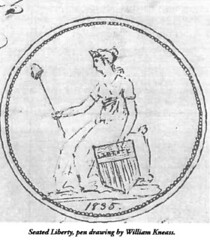
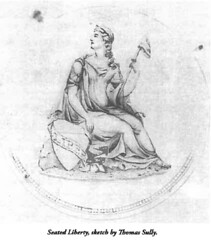
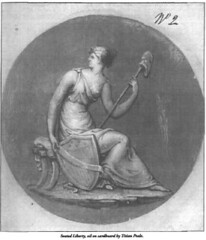
All three of these pieces were done before Christian Gobrecht was hired as an assistant engraver and the commonalities reflect Patterson's specific directions. In each case lady liberty is an attractive, feminine figure, in each case she is seated and in each case she is holding a shield in one hand and a liberty pole in the other. These core elements are so key to the final seated liberty design that it is clear that Patterson was the real author. It is a matter of conjecture as to the genesis of his vision, but the similarity to the figure of Britannia on the reverse of the British penny is undeniable.

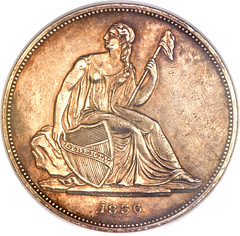
Heritage September 27, 2013 Lot 24933 Great Britain: Victoria Penny Heritage November 1, 2013, Lot 3669, 1836 P$1 Name on Base, Judd-60 The symbolism of lady liberty holding a shield is clear. It represents liberty DEFENDING freedom, and this idea had never been represented before on U.S. Coinage. Defending against who or what ? The obvious answer is against the expanding global colonial aspirations of an increasingly dominant Great Britain. Only 21 years earlier, The British army had invaded the U.S. It seems likely that Patterson's seated liberty vision was in opposition to British power rather than in emulation of their design. In this regard , it is essential to point out that Patterson's vision was of an attractive, feminine, desirable lady liberty as opposed to the militaristic Warrior figure of Britannia. Liberty was an attractive ideal that would draw people to her, not a concept that had to be imposed by force of arms. Design approval goes to President Jackson, who moves away from a feminine lady liberty Because of his keen interest in U. S. Coinage and the reintroduction of the silver dollar, President Andrew Jackson reviewed the design material for the 1836 dollar through his Secretary of Treasury Levi Woodbury. Elvira Clain-Stefanelli, former executive director of the National Numismatic Collection, was responsible for acquiring the letters and sketches of Christian Gobrecht from his heirs. She completed a thorough analysis of all this material and published her findings in an article entitled "from the drawing board of a coin engraver". She writes (p14 "Gobrecht Dollars" by Mark VanWinkle)" And also It is inconceivable that the President was only involved at the final stage given his interest in the dollar project. We know that design material for the reverse eagle was being passed up the chain of command on an ongoing basis, so the same must have been true for the obverse seated liberty design. In a letter of April 14 1836 , Patterson wrote to Secretary Woodbury "Your suggestion that the mouth of the flying eagle should be closed had also been made by us to the artist." Clain-Stefanelli writes (p.9. Gobrecht) as follows : "Analyzing Gobrecht's sketches, I have reached the conclusion that he started to draw his first sketches after Sully's model at the same time comparing it with the Peale figure. Either on his own inclination or following orders or suggestions from his superiors, probably Patterson himself, Gobrecht adopted some basic elements from Peale." Finally, she writes "It was delightfully interesting and challenging to follow step by step...the slow but steady process of Gobrecht himself and his Mint Director to depart from the very appealing design of Sully, creating a more 'lumpy' - to use Woodbury's terminology - figure with a strange forward slump, surrounded by bulky drapery, in the place of Sully's majestic and slender liberty." So it was a gradual evolution, and Woodbury did not like the end result. What about Patterson ? He didn't like Jackson's changes, either. After President Jackson had approved the final design for the seated liberty obverse on January 14 1836, Patterson wrote to Secretary Woodbury (and on to Jackson) to enumerate a series of faults with the final design. Clain-Stefanelli writes (p.15 Gobrecht) "This is positive proof that Patterson went into a very detailed analysis of the sketches prepared by Gobrecht. He must also have been convinced he was competent enough to judge subtle design elements such as 'the left arm is too prominent' requiring it to be 'thrown back and subdued; the left shoulder was too low and too far from the neck; the right arm was too much in the position of pointing; too much confusion of drapery near the left breast and near the right hand; knees were too lumpy ; their articulation not being shown with sufficient distinctness". What was left for Patterson to criticize ? If Gobrecht executed as he was directed, Woodbury disliked the "lumpy" design and Patterson hated almost all the changes, it is absolutely clear that the final design reflected President Jackson's wishes. He had relentlessly removed all traces of femininity from Patterson's vision of an attractive lady liberty ! Gobrecht's name on the base of the 1836 dollar

Heritage November 1, 2013, Lot 3669, 1836 P$1 Name on Base, Judd-60 Prior to 1836, no engraver or designer's initials or name had appeared on any U.S. Coinage and Robert Patterson came from a family steeped in U.S. Mint tradition. Previous researchers (eg : R. W. Julian) have suggested that Patterson was so enthralled with the design that he spontaneously added Gobrecht's name to the base at the last minute. It has been demonstrated that the Edward Cogan letter on which Julian relied was a complete fabrication. It is clear that the name on base was a prominent visual design element and yet it never appeared in any design drawings. The only possible conclusion is that it was added at the last possible moment....and there was only one person who could have made that decision. President Jackson had final approval authority, and we have shown that he was not the least bit hesitant in imposing his will. The contention that Jackson ordered this unprecedented change is further supported by the fact that it was reversed as soon as Jackson left office in 1837. The same team of Gobrecht, Patterson and Woodbury was in place, but Gobrecht's name never appeared on the 1837 seated liberty (same design) dime and half dime even though these coins were so small the name on base would not be noticed. Nor did it appear on any 1838 or 1839 Gobrecht dollars! It never appeared on any of the subsequent seated liberty coinage. The only thing that changed was the departure of Jackson. While it is speculation as to why Jackson made such an unprecedented last-minute design change, it seems likely that it was in direct and immediate response to Patterson's insubordinate letter. It is hard to believe that these two simultaneous events were not related. The 1838 Drapery Added Dime and Half Dime
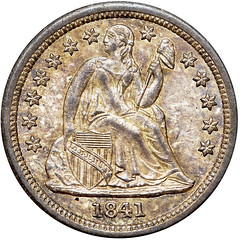
Heritage November 15 2013, Lot 33106, 1841 Dime I believe that after Jackson left office, Patterson and Woodbury moved to correct the seated liberty design to the limited extent possible given that it had been approved and executed. They had some flexibility on the minor coinage (half dimes and dimes) beginning in late 1838 where minor modifications would scarcely be noticed by the public and the unified seated liberty design would still appear to be maintained across all denominations. The changes made corrected most of the structural flaws detailed in Patterson's critical note of mid Jan 1836. The shield was moved to an upright position enabling the arm holding the shield to be closer to the body . The pointing hand was changed to a holding hand and the entire liberty figure was restored to a more upright posture. Finally, Liberty's face was changed to be more feminine and attractive. All the changes that Patterson wanted to make were made, except for the elimination of the drapery on the left and right sides, which would have restored the attractive, feminine lady liberty of Patterson's vision. It is likely that this last step would have resulted in a design too far removed from the rest of the seated liberty coinage. Robert Patterson's Seated Liberty vision realized: the 1841 No Drapery proof dime (two known)

Heritage November 15. 2013, Lot 33322, 1841 10C No Drapery The 1841 No Drapery proof only dime has remained a mystery to this day, with no theory as to what it is and why it was produced. This mysterious coin takes the 1838 With Drapery dime and removes all the excess drapery on the right and left sides of liberty , restoring her feminine beauty. This analysis shows that the 1841 No Drapery dimes address every single one of the design flaws listed by Robert Patterson in his critical letter and returns the seated liberty design to his original vision. Surely, this is not just a coincidence! I believe that either Patterson ordered the design to be executed to ensure his vision would not be lost to history....or it was executed for him by Gobrecht. In either case, it appears that one of these carefully executed proofs (Pr 67 +) was placed in a minor silver proof set for Patterson's mint collection (ref: Numismatic Review 1, 3:29 (1943)). This set would have shown Patterson's vision....the no drapery dime, flanked by the upright shield half dime on one side and Jackson's design on the quarter on the other side. Conclusion Robert Patterson was the true father of the seated liberty design. It was his vision, but it was violated by the move away from an attractive feminine lady liberty, and his role was lost to history by the all capital engraving "C. Gobrecht F." (made by Christian Gobrecht")
An article like this is best presented in print form, but consider this a first draft. I pulled it together from multiple emails and added his chosen illustrations. What do readers think? Perhaps an updated version will find its way to the Gobrecht Journal or The Numismatist.
-Editor
Wayne Homren, Editor The Numismatic Bibliomania Society is a non-profit organization promoting numismatic literature. See our web site at coinbooks.org. To submit items for publication in The E-Sylum, write to the Editor at this address: whomren@gmail.com To subscribe go to: https://my.binhost.com/lists/listinfo/esylum All Rights Reserved. NBS Home Page Contact the NBS webmaster 
|